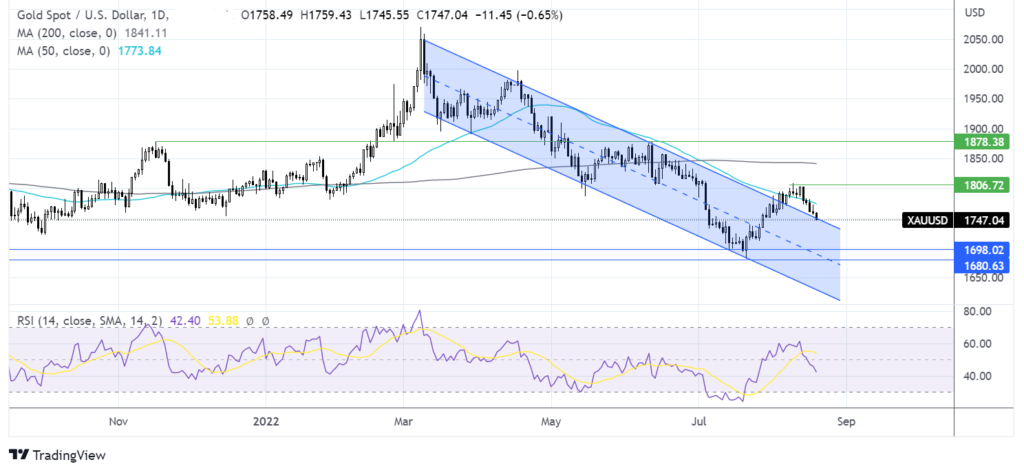PBoC cuts rates and Jackson Hole moves into focus

Gold => The commodity falls below $1750
AUD/USD => The pair rises above 0.69
FTSE => The index holds steady at 7550
Gold struggles at a monthly low
Gold fell for five straight days last week, its longest losing run since November 2021, which saw it shed 3%.
The price fell to a monthly low of $1749 as the USD rallied and bets that the Federal Reserve would keep raising interest rates hit non-yielding gold. This week gold could see more volatility with Fed Chair Jerome Powell’s speech at the Jackson Hole Symposium, where the market will be looking for clues over how high-interest rates may go to tame inflation.
US PC, the Fed’s preferred gauge for inflation is also due to be released. Any sense that the Federal Reserve could implement smaller hikes could lift Gold.

Where next for Gold?
Gold has been trading within a descending channel since March.
In June the price rebounded from the 2022 low of 1680, briefly recapturing the 50 sma before running into resistance at 1808 and falling lower. The price has slipped back below the 50 sma and is testing the upper band of the falling channel at 1747. A break below here could see the downtrend continue, targeting 1680. Meanwhile, should the support hold, the price could look to recover back up to 1808, with a move above here needed to create a higher high.
AUD/USD rises as China cuts benchmark lending rate
AUD/USD was one of the worst performing G-10 currencies last week, dropping over 3% after data from China raised concerns over slowing economic growth and after weaker than expected Australian jobs data sparked fears that the RBA could slow the pace at which it hikes interest rates.
Meanwhile, the USD charged higher last week on optimism that the Federal Reserve will keep hiking rates and on optimism that the US economy could avoid a steep downturn after better-than-expected initial jobless claims. Today the Aussie is rising after the PBoC cut the Loan Prime Rate, the key mortgage reference rate. The supportive approach from the central bank boosts the market mood helping the Chinese proxy and risk sensitive AUD higher.
Looking ahead, Australian services and manufacturing PMI data is due later and is expected to show that both sectors expanded in August. Upbeat PMIs could help lift AUD/USD.
Aus. services PMI Expected: 54(2.1) Previous: 50.9
FTSE holds steady
The FTSE 100 gained 0.6% last week, thanks in part to the weaker GBP.
GBP/USD tumbled 2.5% as UK inflation hit double digits for the first time in 40 years deepening the cost-of-living crisis and surging prices resulting in retail sales falling by more than expected. The index trades around the top of its yearly range above 7550. The FTSE is more exposed than its European peers to China, owing to the heavyweight ratings given to resource stocks.
While news that the PBoC is supporting the economy is keeping the FTSE supported today, a slowdown in China could hurt the FTSE more than its European counterparts. There is no high impacting UK data today. Tomorrow sees the release of UK PMI figures.
Support can be found at 7500 (20 sma) and 7460 (11 August low).
Resistance for the index can be seen at 7575 (August high) and 7600 (June high).
